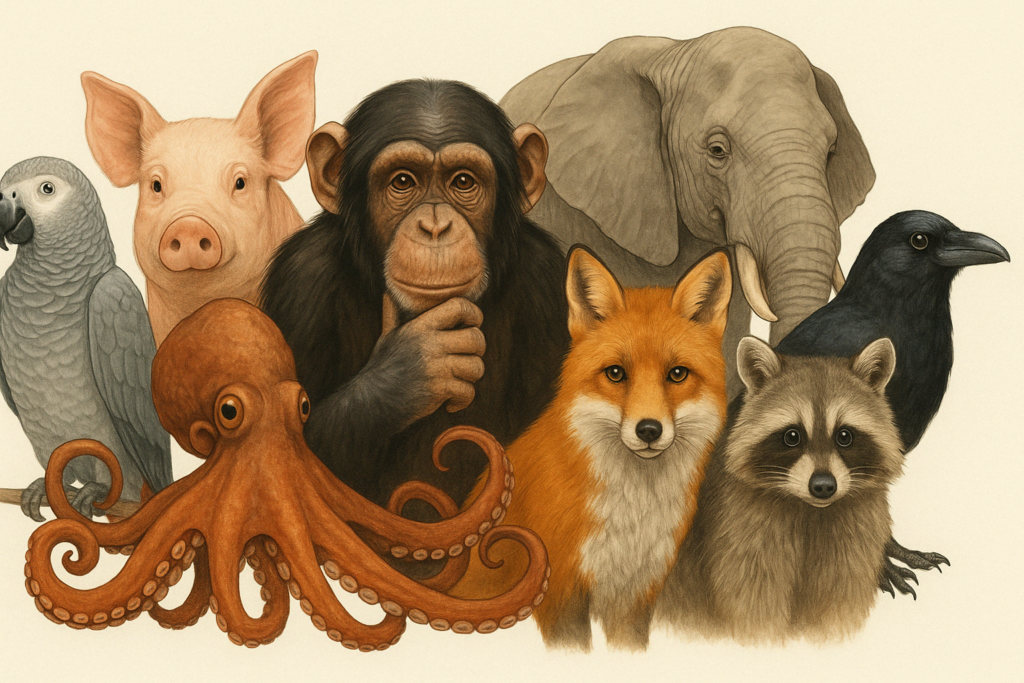
By Michael Gitter
They don’t use smartphones or spreadsheets, but don’t let that fool you—these animals are operating on a whole different level of genius. From fish that use tools to birds that remember faces for years, these creatures challenge everything we thought we knew about animal intelligence. Some have been quietly solving puzzles, using language-like communication, or manipulating their environment in ways that would make any human impressed (and maybe a little unnerved). Whether it’s street smarts, emotional intelligence, or long-term planning, these animals are far sharper than we ever gave them credit for.
1. Crows
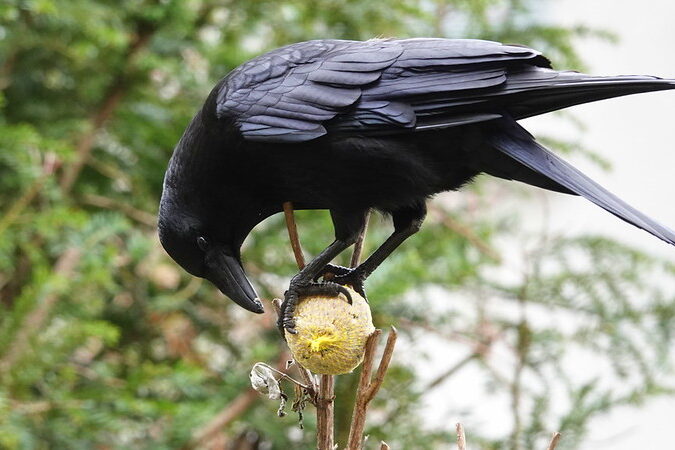
Crows aren’t just clever—they’re calculating. These birds recognize human faces, hold grudges, and even teach others who the “bad guys” are. In a now-famous study from the University of Washington, researchers who had previously trapped crows were attacked years later, not just by the same birds, but by crows who had only heard about the incident. They’d passed the memory down. Crows also use tools, solve multi-step puzzles, and plan for the future—skills once thought to be uniquely human.
In Japan, crows have been seen placing nuts in intersections, waiting for traffic to crack them open, and swooping in when the light turns red. In other words, they’ve learned to manipulate an entire traffic system for lunch. Their intelligence rivals that of great apes, and they’ve earned a sacred place in the folklore of many cultures—from the trickster tales of Native American tribes to the wise messengers of Norse mythology. Source: University of Washington
2. Dolphins

Dolphins aren’t just smart—they’re deeply social, emotionally expressive, and famously curious about humans. In the wild, they’ve been observed swimming alongside boats for miles, mimicking human movements and even making sustained eye contact. Some bring “gifts” like coral or seaweed to divers they recognize. In places like the Bahamas and Western Australia, individual dolphins have formed long-term friendships with humans, greeting them with unique whistles and swimming beside them like old friends. These bonds often last years, sometimes decades.
What makes them so attuned to others? Scientists have found that dolphins possess one of the most developed limbic systems in the animal kingdom—the brain region responsible for emotion and empathy. They form complex alliances, grieve their dead, care for injured pod members, and have even rescued humans from predators or dangerous currents. It’s not just intelligence—it’s compassion with a memory. Source: Discover Magazine
3. Pigs
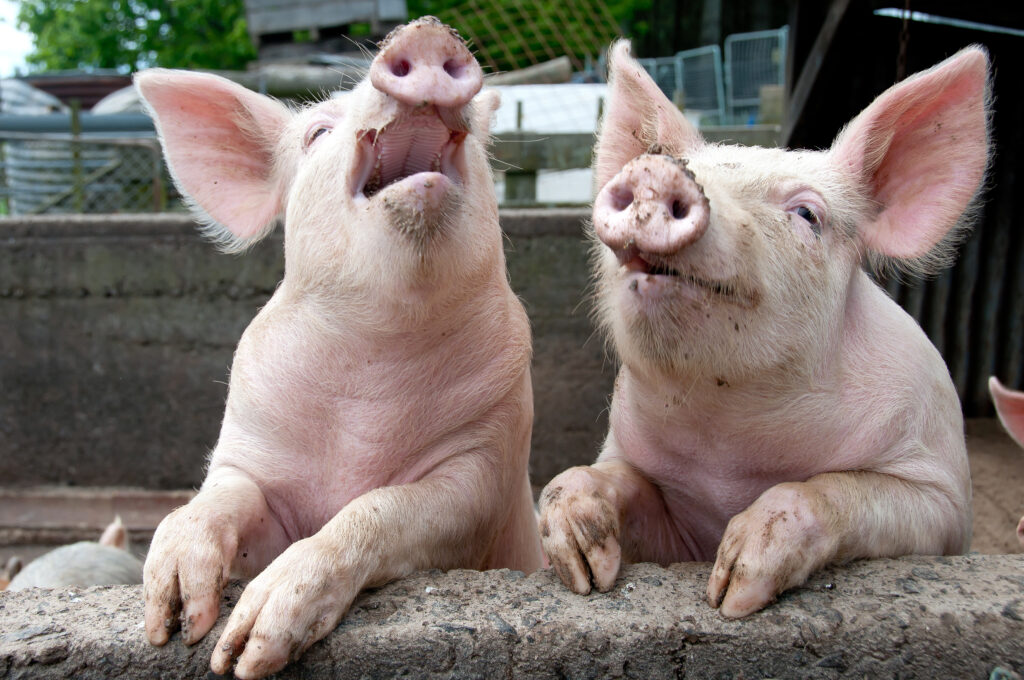
Pigs might roll in the dirt, but mentally, they’re operating miles above what most people expect. These animals can solve mazes, use mirrors to locate hidden objects, and even master video game joysticks. Their memory is outstanding, and they can quickly learn to respond to their names and follow simple commands. Studies have shown pigs performing on par with chimpanzees in certain learning tasks, and their emotional range is just as rich—they express joy, boredom, anxiety, and even jealousy.
Researchers at Purdue University trained pigs to manipulate joysticks to control a cursor on a screen, demonstrating not just physical coordination but cognitive understanding of a game’s objective. These weren’t simple reactions; they showed intention and patience. Pigs are also remarkably social and communicate through a complex system of grunts and squeals that convey specific meanings. If you think a pig’s just farm fodder, think again—they may be one of the most underappreciated minds in the animal kingdom. Source: Purdue University
4. The Octopus
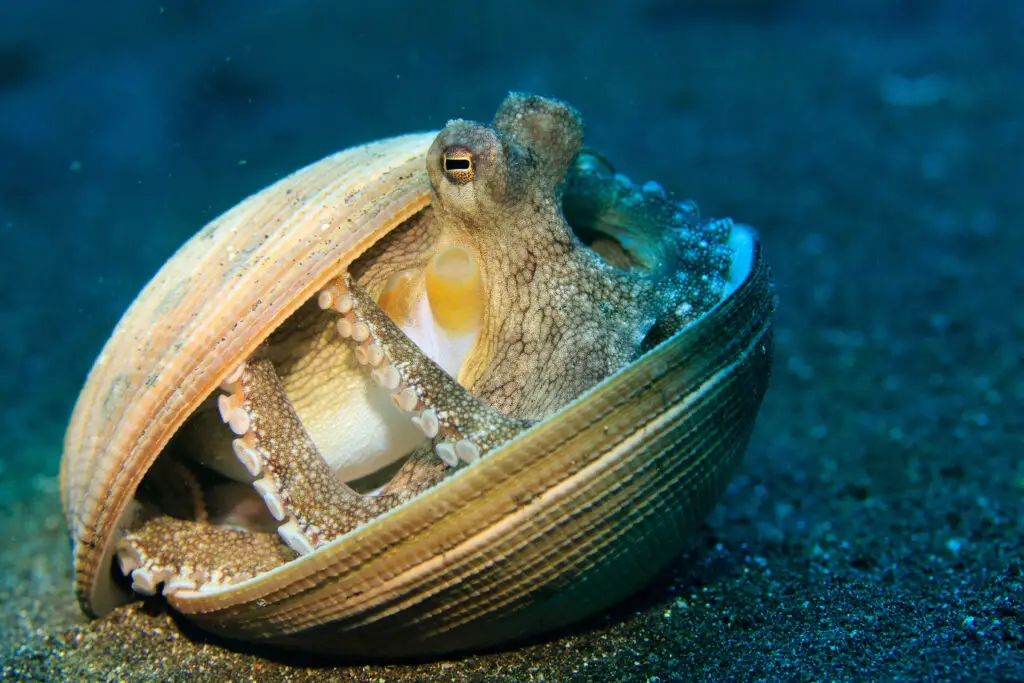
With nine brains, three hearts, and zero bones, the octopus isn’t just strange—it’s strategically brilliant. These marine mollusks can open jars from the inside, solve mazes, and slip through gaps the size of a coin. At aquariums worldwide, octopuses have been caught red-handed (well, red-tentacled) sneaking out of their tanks, crossing floors, and raiding nearby exhibits. Their brains are decentralized, meaning most of their neurons are in their arms, each one capable of independent thought and movement. When an octopus reaches out to explore, it’s not just feeling; it’s thinking.
Scientists at the University of Otago in New Zealand even documented octopuses throwing rocks—sometimes at each other—suggesting complex planning or perhaps passive aggression. Others have been observed using coconut shells as mobile homes, stacking them like armor. Their intelligence isn’t just about survival; it’s about strategy, curiosity, and play. If any creature belongs in a sci-fi heist film, it’s this invertebrate Houdini. Source: Scientific American
5. Rats
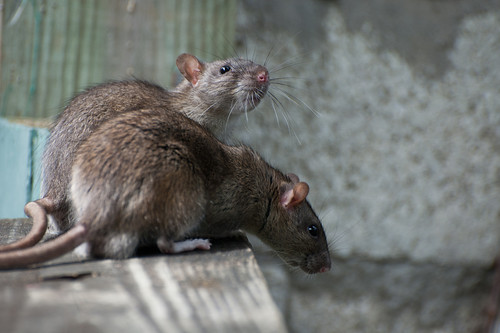
Rats might have a bad reputation in city alleys, but in the lab, they’re nothing short of brilliant. These rodents can learn complex tasks, remember solutions for weeks, and even exhibit behaviors that suggest empathy. In one experiment at the University of Chicago, rats freed trapped cage-mates, even when there was a chocolate reward available. Many chose to rescue their friend and share the chocolate, showing both emotional intelligence and cooperation. They’re also master navigators, able to recall multiple routes and switch strategies when obstacles arise—something even many larger mammals struggle to do.
Their skills go beyond mazes. In Japan, rats have been trained to detect landmines by scent, and in Tanzania, they’re being used to screen for tuberculosis faster than machines. A study published in Current Biology even showed rats exhibiting metacognition—essentially knowing what they don’t know, which is considered a high-level mental process. That puts them in the same elite mental category as primates and dolphins. So yes, they might raid your pantry, but they could also help save your life. Source: University of Chicago
6. Elephants
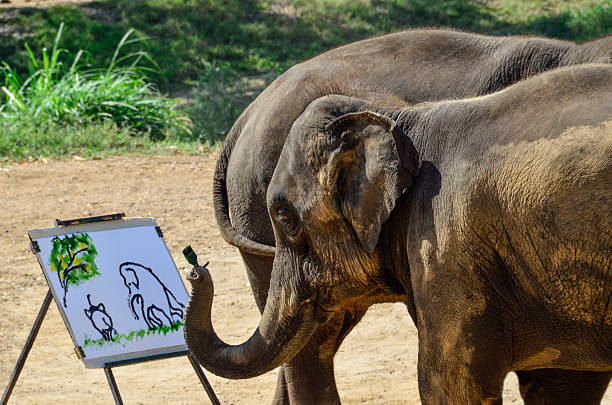
We’ve all heard the phrase “an elephant never forgets,” but their memory is just the tip of the cognitive iceberg. Elephants recognize themselves in mirrors—a rare feat that places them in an elite group of self-aware animals. They can recall distant water sources years after visiting them, recognize individuals after decades apart, and even adjust migration routes based on generational knowledge passed through matriarchs. These aren’t just mental tricks—they’re survival strategies rooted in complex learning, communication, and emotional processing.
In the wild, elephants have been known to mourn their dead, pausing to caress the bones of lost relatives and returning to the same sites of elephant “graveyards” year after year. They comfort distressed herd members, collaborate during rescue attempts, and use low-frequency rumbles to communicate across miles. According to researchers from the University of Sussex, elephants can distinguish between human languages and even tell whether the speaker is male or female—an adaptation developed to assess threat levels in regions of human conflict. Source: University of Sussex
7. Bees

They may be small, but bees are packing big mental muscle. These busy pollinators can count, recognize faces, and even grasp the concept of zero—something, once believed to be exclusive to primates and humans. In experiments, bees have been taught to differentiate between quantities, make decisions based on numerical patterns, and navigate mazes with abstract rules. And they do all this with a brain the size of a sesame seed. Their ability to make rapid, complex decisions in flight also rivals that of advanced drones.
Even more mind-blowing? In a study from the Royal Melbourne Institute of Technology, bees were trained to perform basic arithmetic, learning to add and subtract using color-coded symbols. That level of cognitive flexibility suggests a rudimentary form of symbolic learning, which has major implications for our understanding of consciousness. Bees also communicate through intricate “waggle dances,” encoding the direction and distance of food sources using geometry and timing. Source: RMIT University
8. Parrots
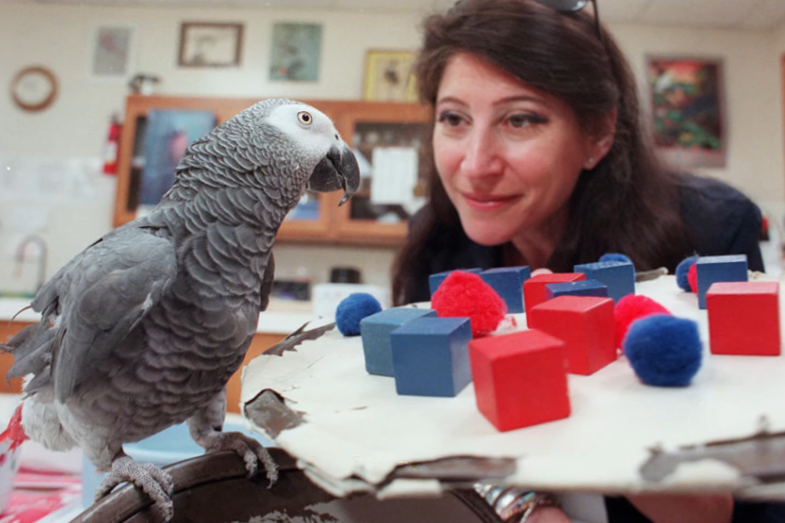
Parrots don’t just repeat what you say—they understand far more than they’re given credit for. African grey parrots, in particular, can learn over 100 words, identify shapes, numbers, and colors, and even understand the concept of zero. They can use words appropriately in context, not just mimicry. These birds solve multi-step puzzles, anticipate outcomes, and respond to human emotion, sometimes even offering comfort. Their brain-to-body ratio rivals that of primates, and they’re one of the few non-mammals to demonstrate true problem-solving under pressure.
Perhaps the most famous example is Alex, an African grey parrot studied by Dr. Irene Pepperberg. Over 30 years, Alex demonstrated the ability to count, differentiate materials, and express feelings like boredom or affection. When he passed away in 2007, his last words to her were, “You be good. I love you.” Alex’s legacy not only touched hearts but also shifted scientific understanding of bird cognition forever. Source: Harvard and Brandeis University.
9. Ants
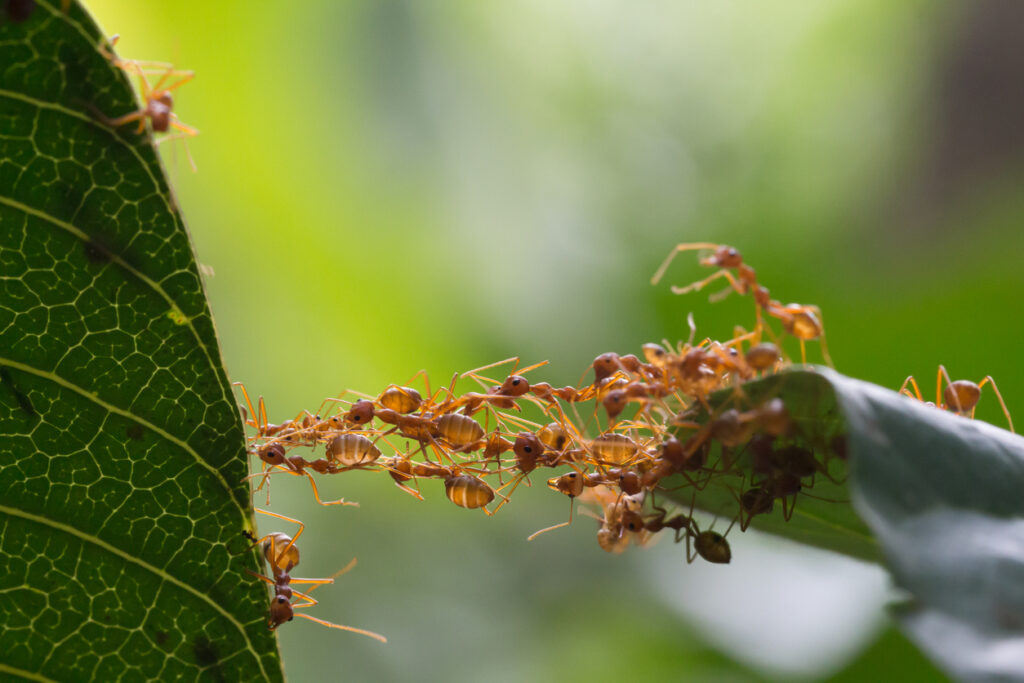
Ants may be tiny, but together, they operate like a single, high-functioning superorganism. Individual ants follow simple rules, but collectively they build vast underground metropolises, defend their colonies with military precision, and even farm and herd other species. Leafcutter ants cultivate fungus gardens underground, cutting leaves not to eat, but to feed their crops. Army ants coordinate massive raids spanning hundreds of thousands of individuals, without a leader, using chemical signals and real-time responsiveness that puts some tech networks to shame.
Their brains are small, but their collective intelligence is staggering. In lab studies, ants have solved navigation problems that stump advanced robots and have been observed adapting their trail networks to find the most efficient routes, even rerouting dynamically when obstacles appear. Some species even “rescue” injured nestmates and carry them back to safety. Their ability to self-organize, solve problems, and react as a swarm to rapidly changing environments is a model now studied in robotics and artificial intelligence.
Source: Smithsonian Institution
10. Raccoons
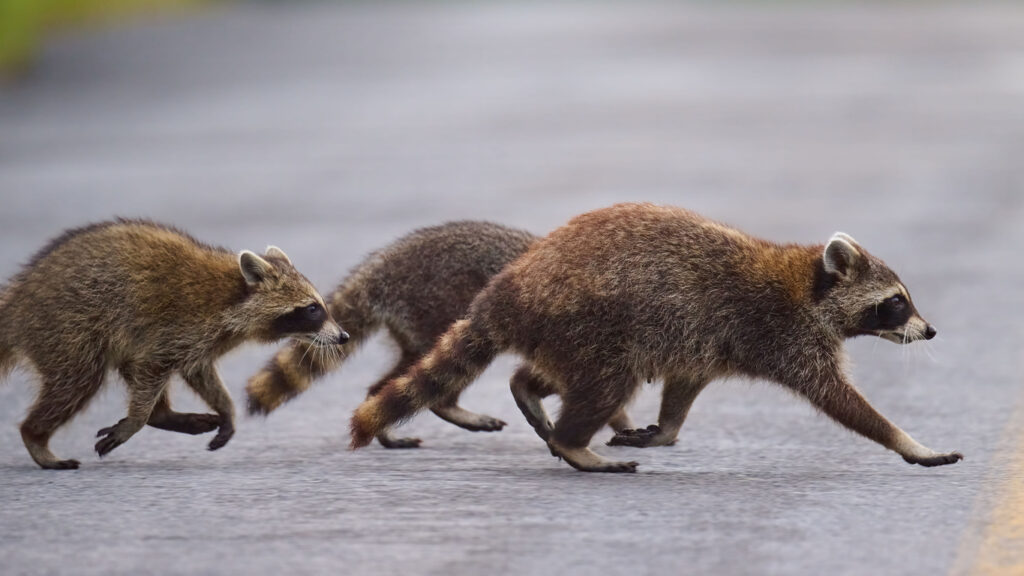
Raccoons have a well-earned reputation as mischievous trash pandas, but behind those masked faces are sharp, calculating minds. They can open locks, unlatch cages, and even remember solutions to tasks for years. In one early 20th-century study, raccoons figured out how to open 11 out of 13 complex locks—and some could do it in under 10 tries. Their nimble paws function almost like hands, and they use them to explore objects with a kind of tactile curiosity more common in primates than other mammals.
More recent studies have shown that raccoons can perform on par with monkeys in cognitive tasks, including learning through observation, problem-solving under pressure, and even manipulating touchscreens. In urban environments, they’ve adapted brilliantly—learning to navigate human infrastructure, open garbage bins with moving parts, and even memorize trash collection schedules. They’re not just surviving alongside us; they’re studying us, learning, and evolving with the cityscape. Source: University of Wyoming
11. Dogs: The Emotional Strategists We Live With

We’ve always known dogs are loyal, but they’re also highly intelligent social strategists. They read human facial expressions, understand over 100 words (some breeds much more), and can follow gestures like pointing—something even chimpanzees often struggle with. Dogs not only learn verbal cues, but many have also figured out how to manipulate human behavior to get what they want, from feigned limping to “guilt faces” that trigger a response, even when they haven’t done anything wrong. They’re reading us like books.
In cognitive studies, border collies like Chaser have memorized over 1,000 object names and can retrieve them by category. Other dogs have been trained to detect diseases like cancer or diabetes through scent, showing an uncanny ability to connect patterns with reward. Their skills aren’t limited to tricks—they’re masters of emotional attunement. Dogs can mirror our moods, offer comfort during distress, and even detect subtle hormonal changes. Source: Duke University Canine Cognition Center
12. Orangutans: The Quiet Geniuses of the Canopy
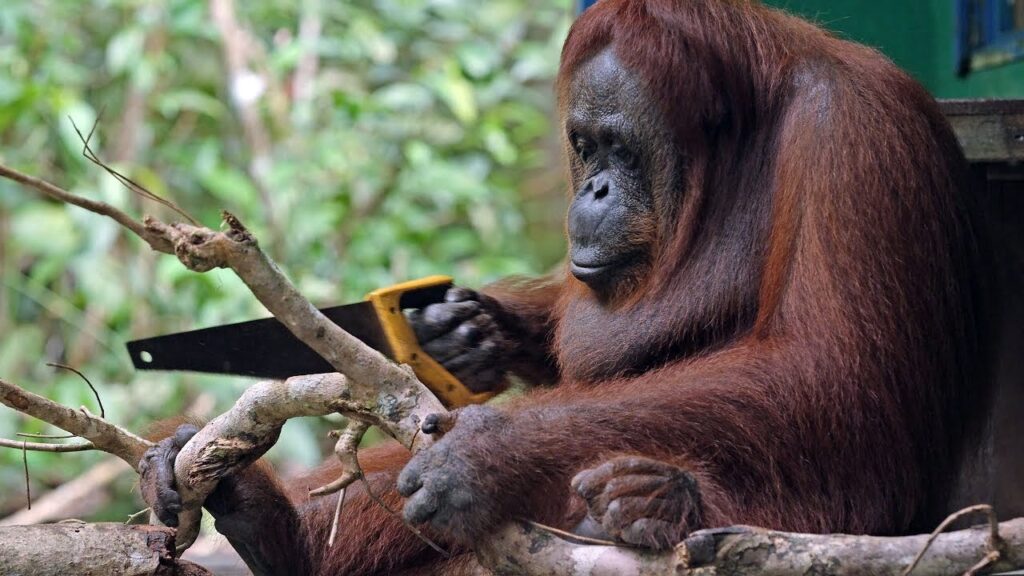
Orangutans may be solitary, but their brains are anything but quiet. These great apes use tools in the wild, from sticks to extract termites to leaves as makeshift umbrellas. In captivity, they’ve been observed using siphons to drink juice and even hot-wiring electric fences. Their ability to imitate human behavior is so advanced that some have learned to wash clothes, paddle canoes, and mimic speech-like sounds. What sets them apart isn’t just what they learn, but how quickly they adapt and teach others.
They also pass down cultural knowledge through generations, one of the rarest forms of intelligence in the animal kingdom. In Borneo and Sumatra, wild orangutan groups have distinct dialects, tool-use traditions, and grooming customs. One orangutan in a German zoo even escaped his enclosure using a branch, a tarpaulin, and strategic timing—an act of clear foresight and planning. These red-haired thinkers don’t just survive in the treetops—they innovate. Source: Max Planck Institute for Evolutionary Anthropology
The Minds We Never Saw Coming

Turns out, intelligence isn’t always packaged in a lab coat or behind a pair of opposable thumbs. From tool-wielding octopuses to math-savvy bees, the animal kingdom is bursting with minds that challenge everything we thought we knew about brains, behavior, and even emotion. These creatures plan, grieve, count, lie, collaborate, and sometimes outsmart the very scientists studying them. And the more we dig, the more it becomes clear: intelligence isn’t rare—it’s just wearing different faces.
So the next time a raccoon outwits your garbage lock, or a parrot side-eyes you mid-conversation, don’t be too quick to laugh it off. They may not have degrees or TikTok accounts, but many animals are running cognitive circles around us—and doing it with flair. We’re not alone in the realm of big thinkers. We just finally caught on.


